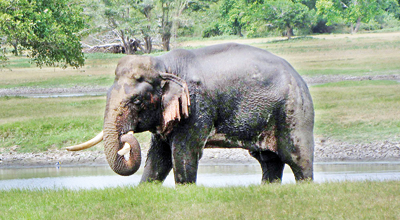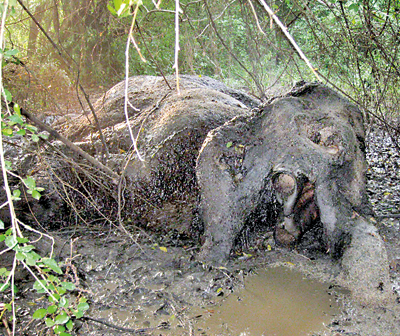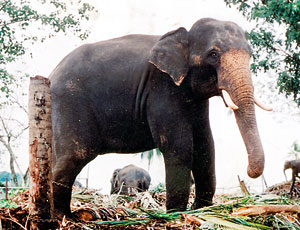News
Tusks sawn off carcass of Mahakanadarawa Tusker
The famous blind elephant known as the “Mahakanadarawa Tusker” is dead. Its badly decomposed carcass minus the tusks was discovered last week on the banks of a reservoir in Medawachchiya. The tusks had been sawn off. It is not clear whether the animal died from natural causes or whether it was killed. Police are investigating.
Veterinary surgeon Dr. Chandana Jayasinghe, who conducted the post-mortem, told the Sunday Times that the animal would have been dead for about 10 days and that it was hard to determine the cause of death due to animal’s advanced state of decomposition.

Once he was a majestic tusker (above); now (below) all that remains of him is a badly decomposed carcass minus the tusks. Pix by Athula Devapriya

The majestic tusker is believed to have been about 45 years old. Its tusks were about three feet in length. The animal used to roam in the vicinity of eadawachchiya, Kebitigollewa, and Hundugala, and villagers said he was not a “trouble-maker.”
The tusker had come in search of water during a period of drought and had remained in the vicinity of the Mahakandarawa tank. Villagers referred to the animal as the Mahakanadawara Tusker. The animal was blind in one eye and had vision problems in the other eye, according to Dr. Jayasinghe.
About three months ago the tusker was badly wounded in a fierce battle with a bull elephant that was dominating the Mahakanadarawa area. The tusker was in a weak state for some time, but recovered and returned to its home ground in Medawachchiya once the rainy season set in.
This is not a good time for tuskers. State veterinary surgeons are treating two other wounded tuskers, one a young tusker of about 15 years that was found in Kalawewa with gunshot wounds on its leg. Dr. Jayasinghe believes the elephant was a victim of a trap gun.
Last month another tusker died in Kochchikattuwa, Puttalam. Dr. Jayasinghe said the animal had difficulty walking because of a fractured hip joint. The injury could have been the result of a battle with another elephant or a roadside accident. The well built young elephant was about eight feet tall, said wildlife sources.
Dr. Chandana Jayaratne, who is the chief government veterinary surgeon in the area, believes that at least three tuskers have been killed so far this year. Many of the deaths were the result of human-elephant conflict.
Wildlife experts fear ivory hunters may be operating again. Not all male Asian elephants develop tusks. An elephant census conducted last year showed that Sri Lanka accounted for only 7 to 8 per cent of the total male Asian elephant population. Some parts of Asia have much higher concentrations of tuskers.
Scientists say the distribution of tuskers depends on the elephant gene pool of each region. In Sri Lanka, tuskers are highly valued as cultural and religious icons. Elephant activists say elephant sanctuaries should be well protected and the elephants allowed to roam freely in order to maintain a healthy population of tuskers.
Many of the areas where tuskers once abounded are shrinking with deforestation and development programmes. The elephant habitat in Kalawewa, which once had a flourishing elephant population, is shrinking as illegal human encroachment continues. The Kalawewa elephant herd has produced many majestic tuskers.
The Department of Wildlife Conservation is offering a reward for any information that could lead to the recovery of the Mahakanadarawa elephant’s missing tusks.
In May this year, Sri Lanka Customs seized 359 African elephant tusks that were being smuggled through Sri Lanka.
Follow @timesonlinelk
comments powered by Disqus


















